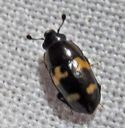Glischrochilus
Glischrochilus
Classification
- Phylum: Arthropoda
- Subphylum: Hexapoda
- Class: Insecta
- Order: Coleoptera
- Suborder: Polyphaga
- Superfamily: Cucujoidea
- Family: Nitidulidae
- Subfamily: Cryptarchinae
- Genus: Glischrochilus
Pronunciation
How to pronounce Glischrochilus: //ˌɡlɪs.kroʊˈkaɪ.ləs//
These audio files are automatically generated. While they are not always 100% accurate, they are a good starting point.
Images






Summary
Glischrochilus is a genus of sap-feeding and predatory beetles known as picnic beetles or beer bugs, recognizable by their distinctive coloration and size. They predominantly feed on decaying matter and are significant in both ecological roles and as pests in agricultural settings.
Physical Characteristics
Oblong shiny black beetles with attractive yellow, red, or orange markings on their elytra. Average size is 5 mm in length, with some specimens reaching up to 12 mm. Characteristic 11-segmented antennae that end in a 3-segmented club. Larvae are approximately 6.4 mm long and milky white.
Identification Tips
Short elytra that expose the last abdominal segments, distinguishing them from larger Megalodacne beetles. Adult Glischrochilus have unique 11-segmented antennae and are smaller compared to other beetle families.
Habitat
Usually found near decayed plant matter, ripening fruits, and locations where sap exudes from injured trees.
Distribution
Widespread in North America and Eurasia, with most species being more diverse in Southeast Asia.
Diet
Adults feed on exuding sap, decaying vegetable matter, and fermenting liquids like beer and vinegar. Some species are obligate or facultative predators of soft invertebrates.
Life Cycle
Lifecycle includes egg, larval, pupal, and adult stages, with an average development time from egg to adult taking a little over a month. One generation is produced each year.
Reproduction
Eggs are milky white and sausage-shaped, laid in spring near decaying plant matter.
Ecosystem Role
Involved in the decomposition process by feeding on decaying organic matter and also play a role in the transmission of plant pathogenic fungi.
Economic Impact
Considered pests of certain crops, especially when fruit is damaged or overripe, as they attract large numbers and can ruin outdoor gatherings.
Cultural Significance
Commonly referred to as picnic beetles or beer bugs due to their attraction to food and beverages, often ruining picnics and gatherings.
Collecting Methods
- Using scent baits that include beer, vinegar, molasses, and fruit juice.
Preservation Methods
- Pinning
- Ethanol sampling
- Drying specimens
Similar Taxa
Misconceptions
Often mistaken for other similar beetles due to size and elytra appearance, and misidentified as part of the now reclassified genus Ips.
Tags
- beetles
- Nitidulidae
- ecosystem
- pests
- insects
- sap beetles
- Glischrochilus